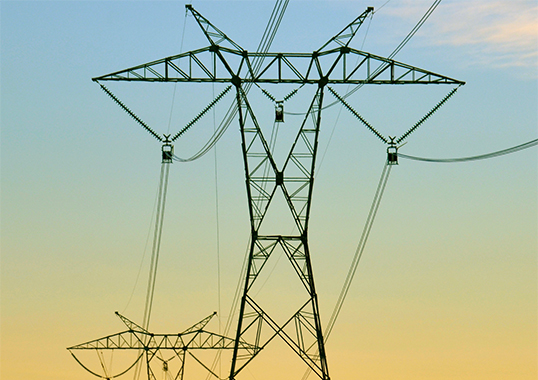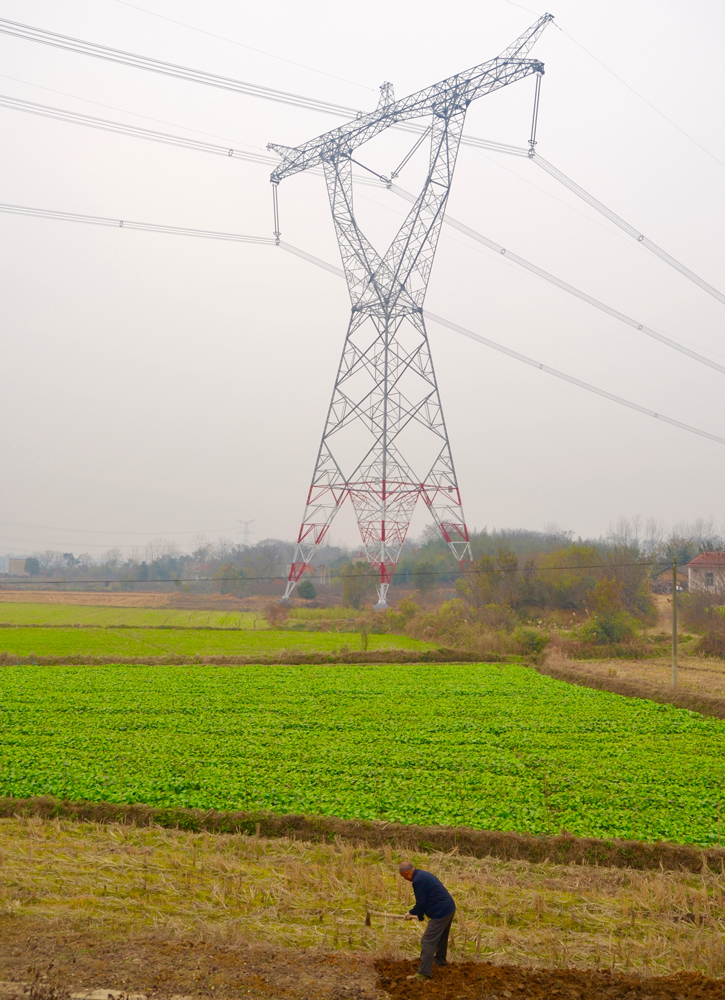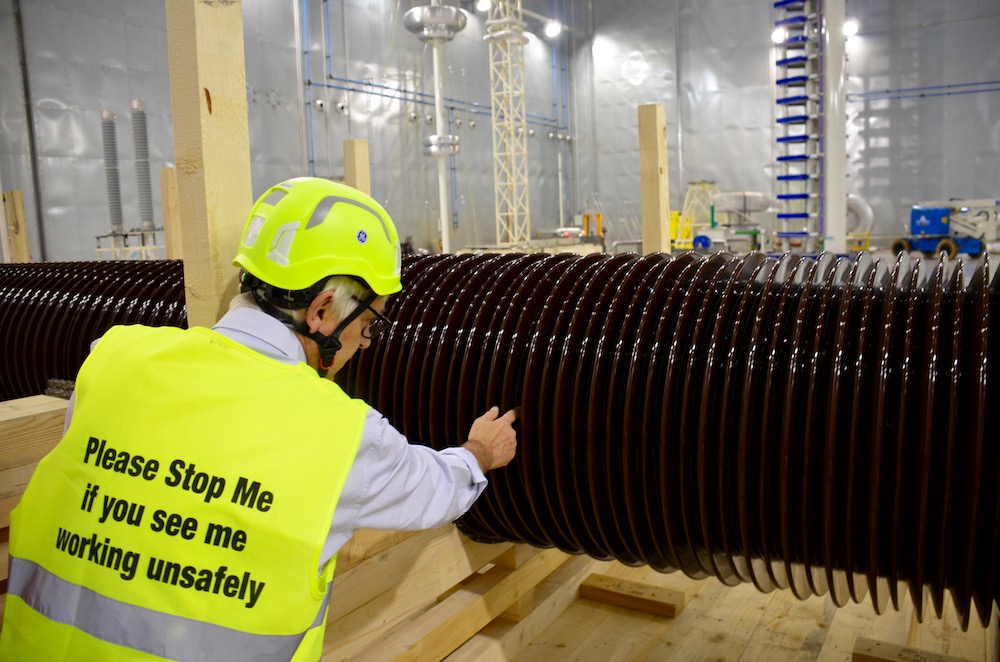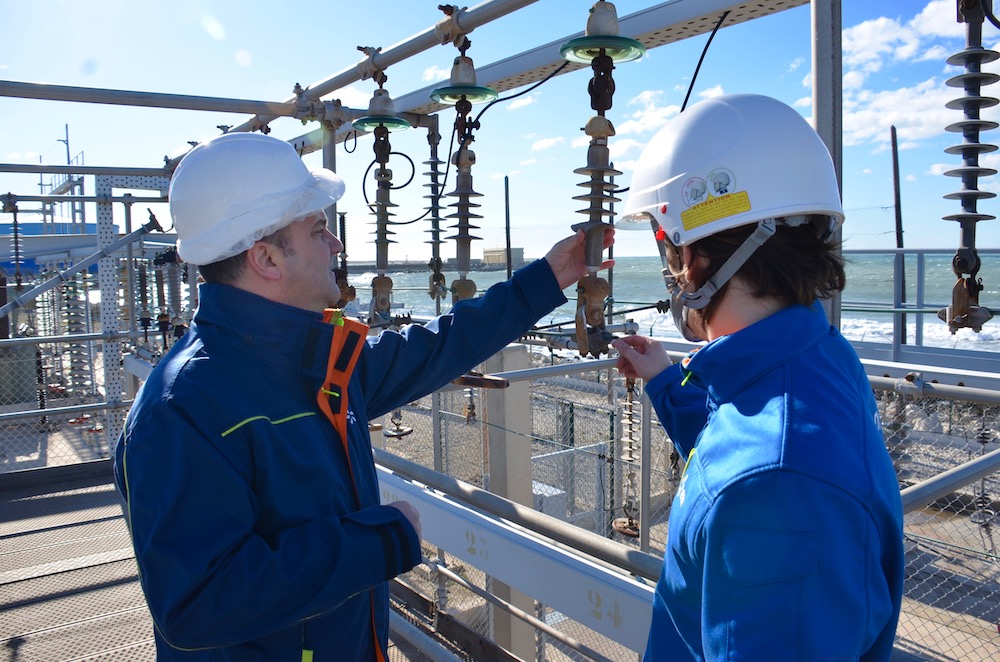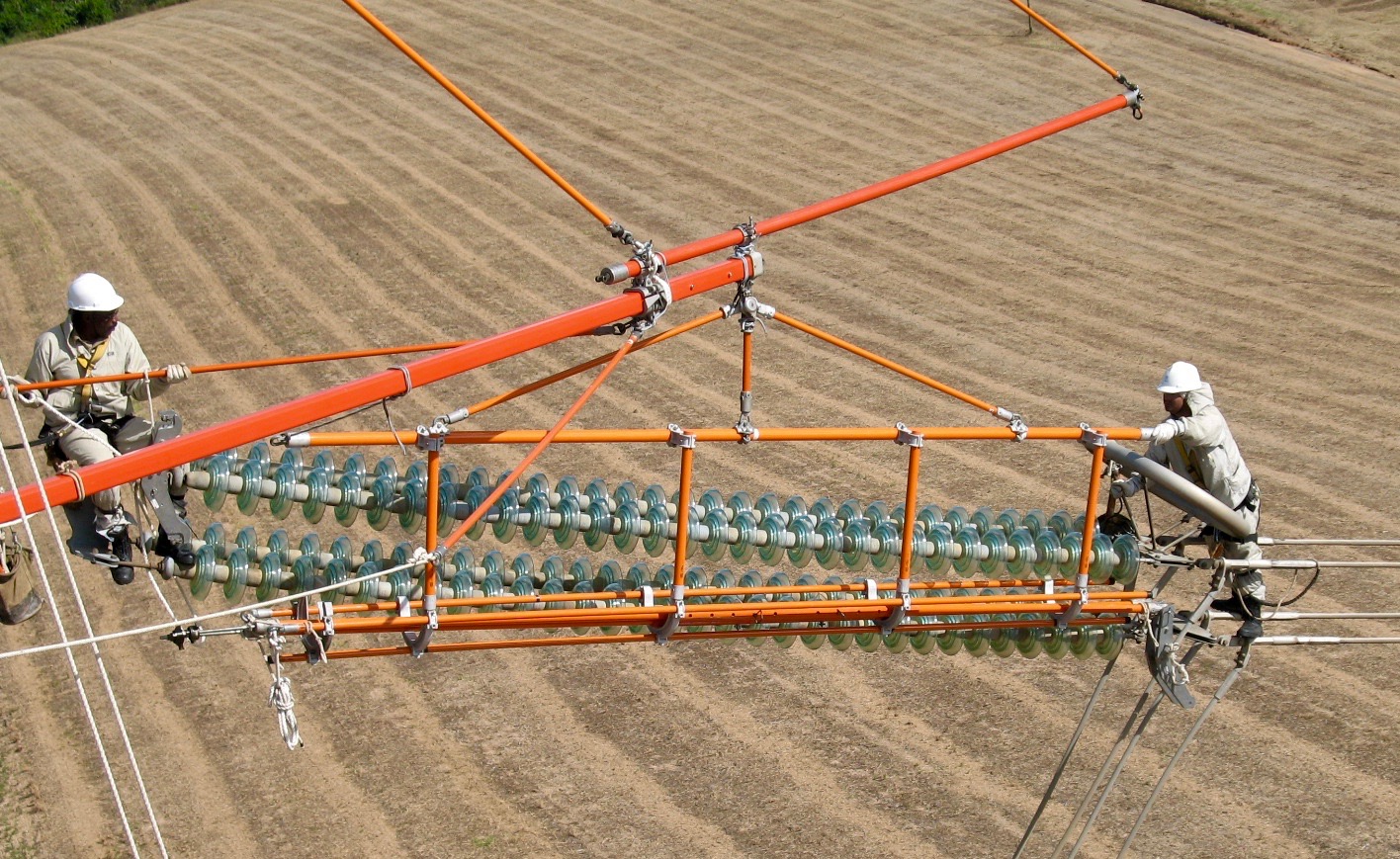Over the next weeks, INMR will present selections from its archive of photos assembled over 30 years visiting power lines, substations, equipment factories and test laboratories across the globe. Some images are technical and tell a story while others showcase unique power infrastructure and how it appears against the backdrop of natural environments.
The common thread of the images in Part 1 of this series is the presence of people who design, build, test, maintain or simply live alongside power infrastructure.
Martin Portillo, former Maintenance Manager for Spanish TSO Red Eléctrica, is reduced to a speck alongside one of the world’s most massive transmission structures – the Matagorda Tower outside the ancient city of Cádiz. One of a pair of monumental 158 m structures, it was built in the late 1950s to support the more than 1 km bay crossing of a double circuit 132 kV line. Designed by Italian, Alberto Toscano, each hollow conical mast with 20.7 m diameter at base and 6 m at the top consists of galvanized steel sections held together by diagonal girders due to limitations in the strength of steel available at the time. Inside, a helical staircase ascends to the crossbar, although an external elevator was also added for those not inclined to make the dizzying ascent.
Construction of new lines such as the ±500 kV WATL Project at Canadian utility AltaLink is done year-round – even during the bitter cold Alberta winter when temperatures can plummet to -30°C and below (as during this image). Even under such extremes, intrepid line contractors still begin each day with the rise of the sun.

This image was captured on a smoggy December morning near the town of Jingmen in central China. In the foreground, as for centuries, an elderly yet plucky figure relies only on the power of her legs and back. Looming behind her, shrouded in the morning fog, a mammoth 1000 kV substation delivers enough power to light the homes of millions.
An elderly Chinese farmer tills his field by hand in the shadow of a 1000 kV tower that stands directly over his humble family plot – a stark reminder that progress can sometimes literally pass over certain segments of society.
An unexpected look of approval is evident on the faces of these maintenance workers and accompanies a changeover in cutout technology at FortisBC, based in British Columbia, Canada. While pollution is rarely a source of problems in this service area, large temperature swings impact how line components age. Summers are hot and dry while winters are cold with substantial precipitation. For years, this type of weather pattern had required these workers to monitor and replace porcelain fuse cutouts damaged by moisture penetration, freezing and cracking.
Israel Electric’s maintenance strategy to ensure reliable operation of a broad range of HV apparatus relies on teams of predicative maintenance specialists. These specialists routinely visit substations to conduct inspections using a variety of diagnostics, including thermal, acoustic, ultraviolet and visual. Findings of any incipient problem are then communicated internally to those responsible to schedule appropriate remedial action in a timely manner.
RTV silicone coatings are now being used more extensively than ever, both at stations and on overhead lines. For example, starting in 2006, the huge Ibiuna 600 kV Converter Station outside São Paulo, Brazil was entirely coated, including station posts, bushings as well as all insulators on the overhead lines entering the station. Past problems on insulators were due to pollution accumulation as well as colonies of algae that had formed on surfaces, creating the need for costly periodic washing. The work involved ‘dead’ application of coatings on weekends over a two-month period. Each team made up of 11 workers typically spent 9 hours per day applying some 80 kg of coatings to a total of 1300 individual sheds.
The Engineering Manager at GE Grid’s production facility near Milan, Italy examines the joint on a UHV bushing’s porcelain insulator prior to testing in the high voltage laboratory. The hardhat and message on his matching safety vest highlight how companies in the high voltage sector have focused on bringing greater safety into all aspects of their operations.
One of the first applications for composite hollow core insulators back in the 1990s was near Cornwall, Ontario where these were used as inverted posts on gantries not able to support the weight of porcelain equivalents. At the time, handling such insulators was in its infancy and workers naturally applied the same techniques used for porcelain. Over time, however, key lessons were learned that inappropriate handling, such as hoisting such an insulator by its sheds, can cause of irreversible damage even before it is placed into service.
Erik Bystrup stands proudly alongside the Eagle Tower, which his firm designed for Danish TSO, Energinet. Bystrup was an architect of civil works when he became captivated by finding new designs to replace the lattice towers he regarded as blighting natural landscapes. Thanks to his vision, many transmission utilities now look at tower appearance as much as function in new projects.
Maintenance workers battled in January 2008 to remove heavy ice accretions from transmission towers in southern China. The unprecedented ice storm still damaged nearly 1200 km of transmission lines as over 4000 transmission towers collapsed.
Workers in the Florida Keys prepare to remove a rusted porcelain line post from a 138 kV line exposed to heavy maritime pollution. This post was eventually replaced by a polymeric one, with the expectation of superior performance in this environment. Another noteworthy element is what is written on the baseplate – a message intended for someone named Joe.
Assessing pollution exposure across the vast Cape Province of South Africa requires someone dedicated enough to drive thousands of kilometers each month visiting the many substations across this vast expanse. Here, Robbie Watson prepares to remove reference string discs to assess ESDD on each, with the exception of the top and bottom units, which serve as dummies.
Outdoor test stations have come to be regarded as one of the most realistic means to assess performance of components such as insulators and cable accessories in harsh service environments. Christian Pons (left) of EDF Lab Les Renardières inspects test specimens at the Martigues Test Station on the heavily polluted coast of southern France.
This new ± 525 kV line in Norway traverses mountains with valleys that drop as much as 400 m. Ground conditions are rocky with little topsoil and sections of line route are accessible only by the helicopters that played a crucial role in construction, with tower elements pre-assembled at special sites and airlifted to tower locations. Statnett developed a new design of AC tower using circular hollow section profiles and this concept was applied for this new DC line by removing one of the cross-arms and extending the remaining ones. Selected because it offers high strength in relation to weight, tower sections are supplied with pre-loaded bolts whose tightening procedure follows a pre-determined sequence.
Andrew Renton of Transpower Asset Development and Cameron Wallace of Electropar were closely involved in development and testing of a novel busbar concept at Drury Substation in New Zealand. Successful implementation of the unique under hung busbar system relied on two factors: innovative application of composite post insulators and development of a new disconnect clamp. Both were key requirements in eliminating the bus side disconnector one would usually expect to find in such a switchyard.
What appears live line maintenance work underway was actually a training exercise for engineers at a major Brazilian utility during the first decade of 2000. The goal was for internal staff to acquire direct experience with what takes place in the field during live line maintenance.
Engineers from German TSO, 50Hertz, lend scale to a test section of 400 kV line with significantly reduced height and width than traditional structures. Another goal for the new tower was reduction of dimensions at the bottom. The suspension tower was eventually designed as a single tubular, conical steel pole with ring flange connections. The dead-end tower was designed as portal type, consisting of two tubular, conical steel poles supporting the cross-arm.
Although the proportion of wooden poles affected annually by pollution induced pole top fires at Australia’s Western Power was less than 0.1 per cent 20 years ago, that still meant several thousand fires to cope with each year. Washing was time-consuming and costly and came with the challenge of how best to decide when it should be done. To deal with the problem, the utility started live application of RTV silicone coatings to distribution insulators exposed to pollution so as to prevent problems from excessive leakage current.
Following destruction by avalanche of towers on two 300 kV circuits in the coastal mountains of British Columbia, during the winter of 1954-55, the late Brian White proposed the concept of catenaries on which phase conductors would be supported. In 2008, that concept was applied once more for that same double circuit line, only one span away and for the same reason. In this image, workers prepare to hoist the RA phase for attachment to the triple insulator string. These catenaries permit a span for the two circuits’ 6 large 3,364 kcmils conductors of circa 2450 m from one pair of standard lattice towers to the next, i.e. over an area of some 1250 x 2500 m across an avalanche prone valley there are no towers at all. Access for inspection and maintenance is by helicopter pads mounted on the cables and about 150 m above ground.
In this photo of infrared inspection at a 138 kV substation in Florida, the definitive factor in condition assessment of assets is not absolute temperature but rather how temperature of the item being inspected compares to the reference temperature of similar items nearby. IR imaging also requires the inspector to be aware of meteorological parameters since it is affected by humidity as well as wind conditions.
__________________________________________
READ PART 2 OF THIS ARTICLE
[inline_ad_block]

